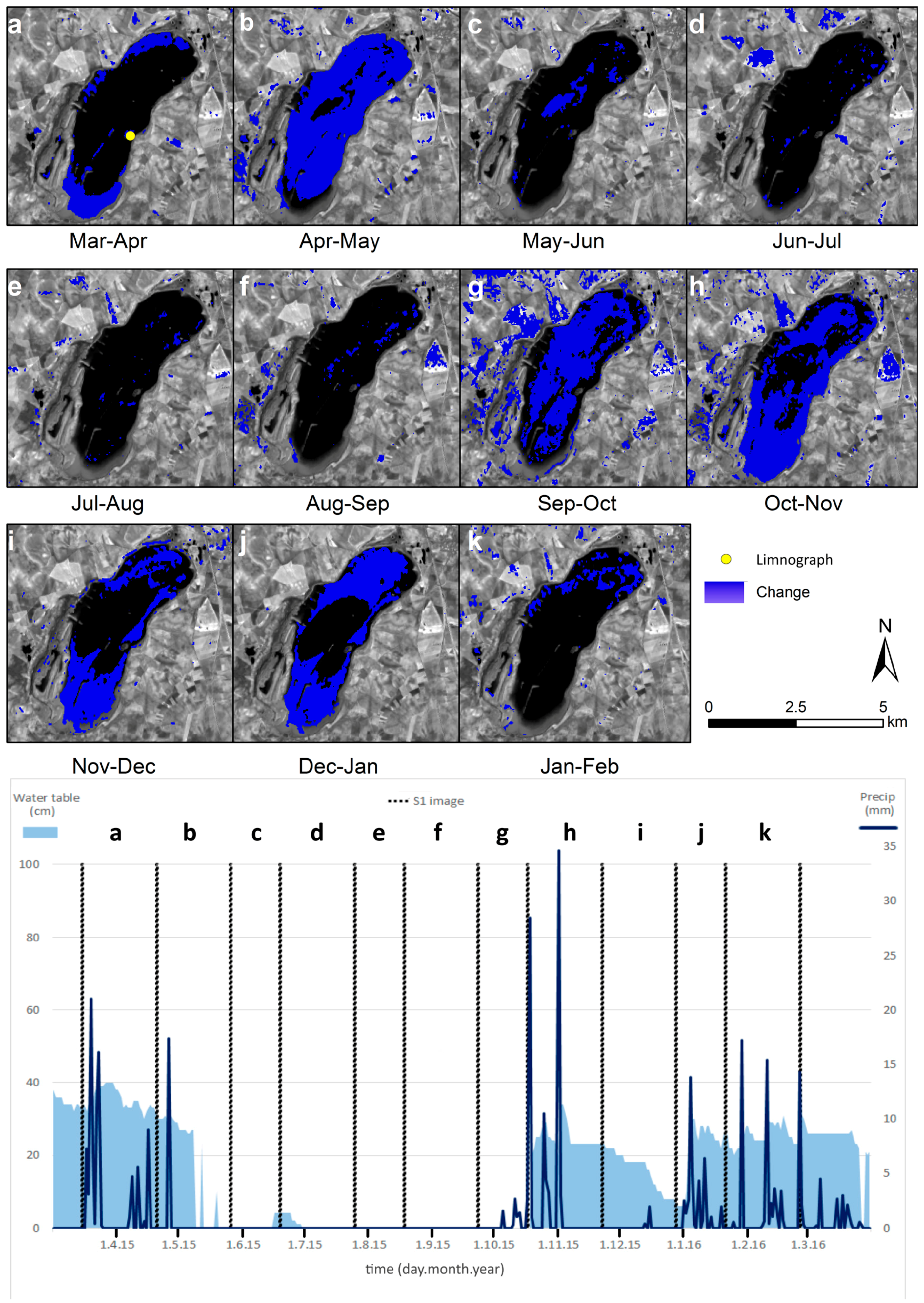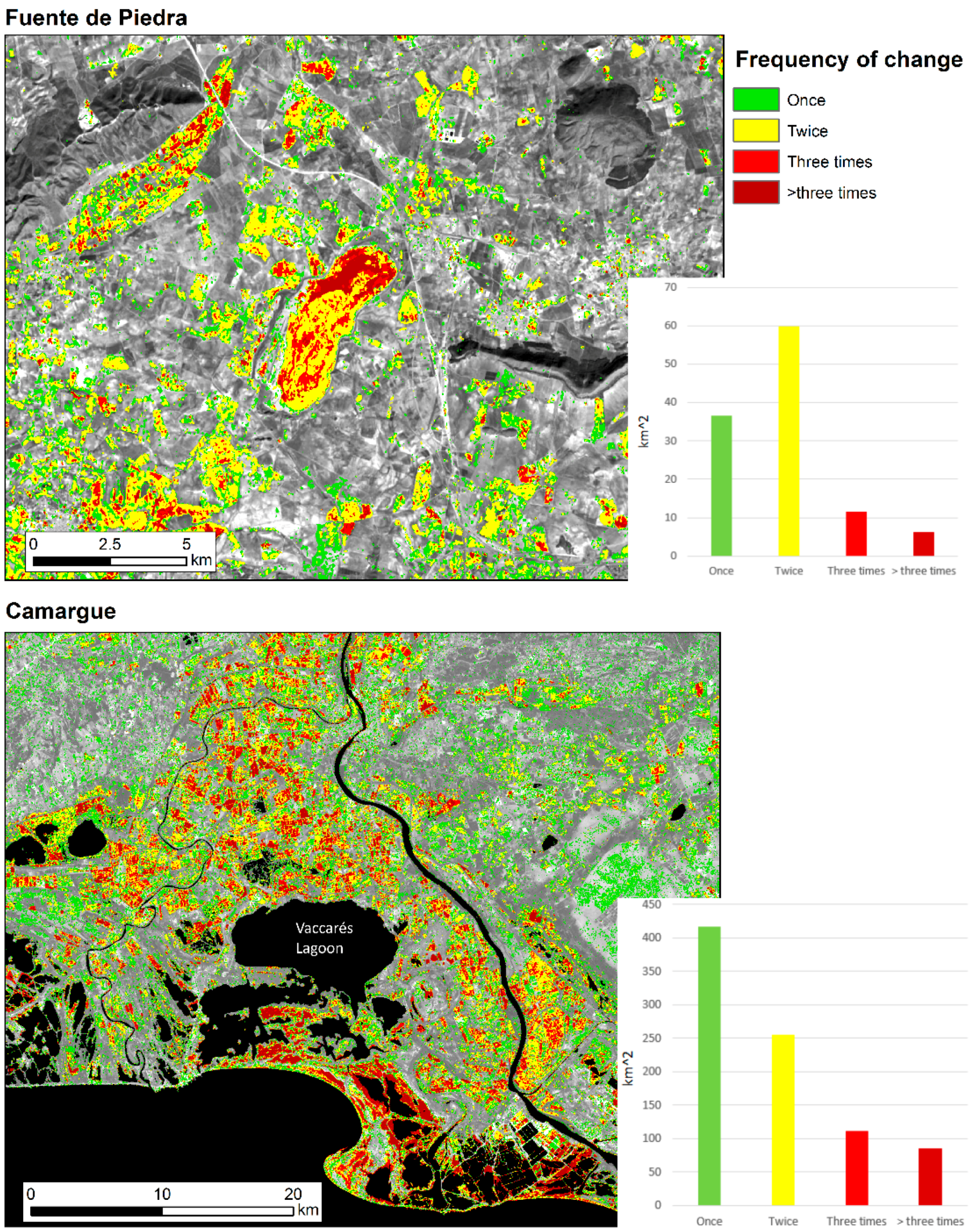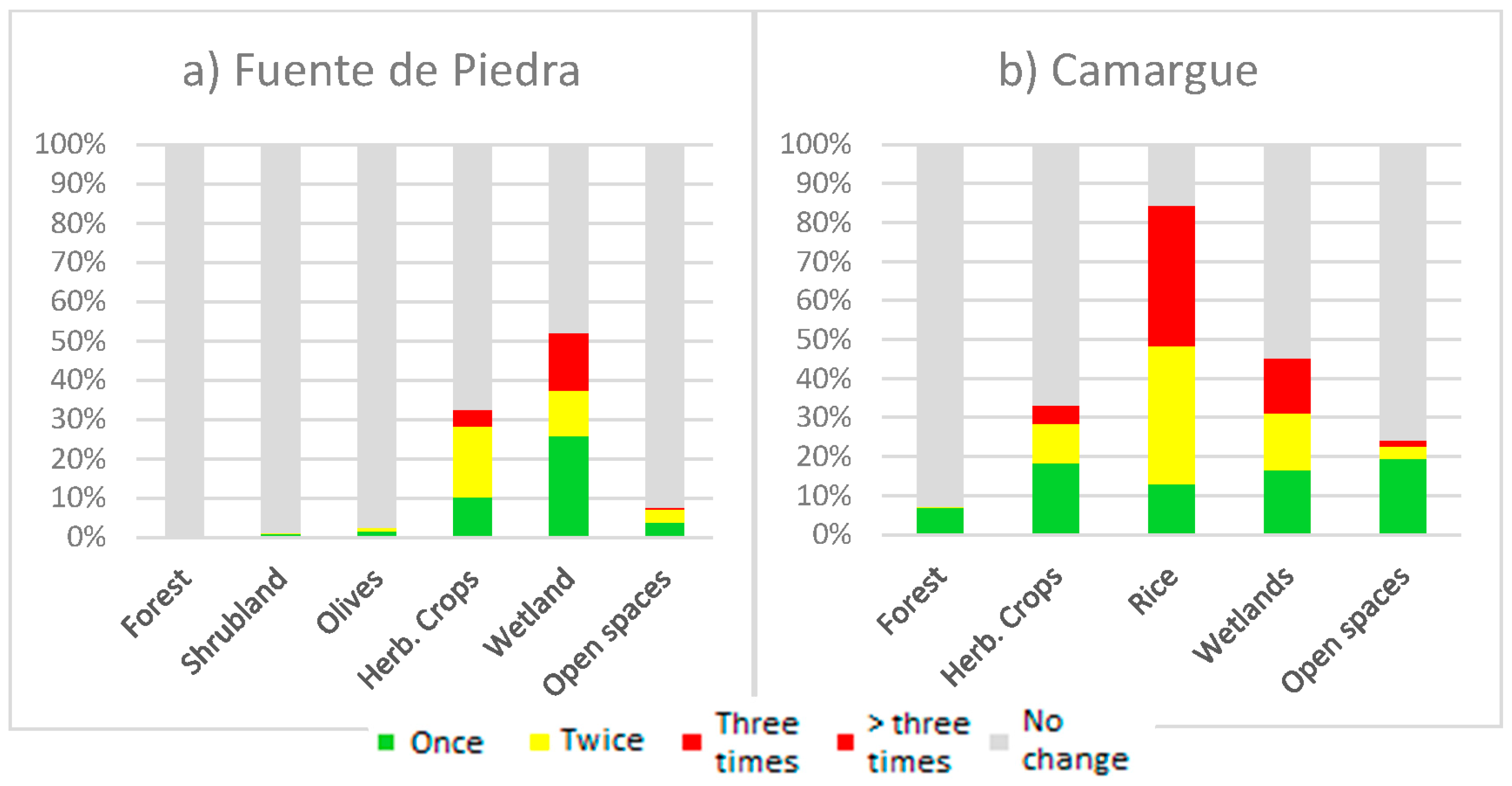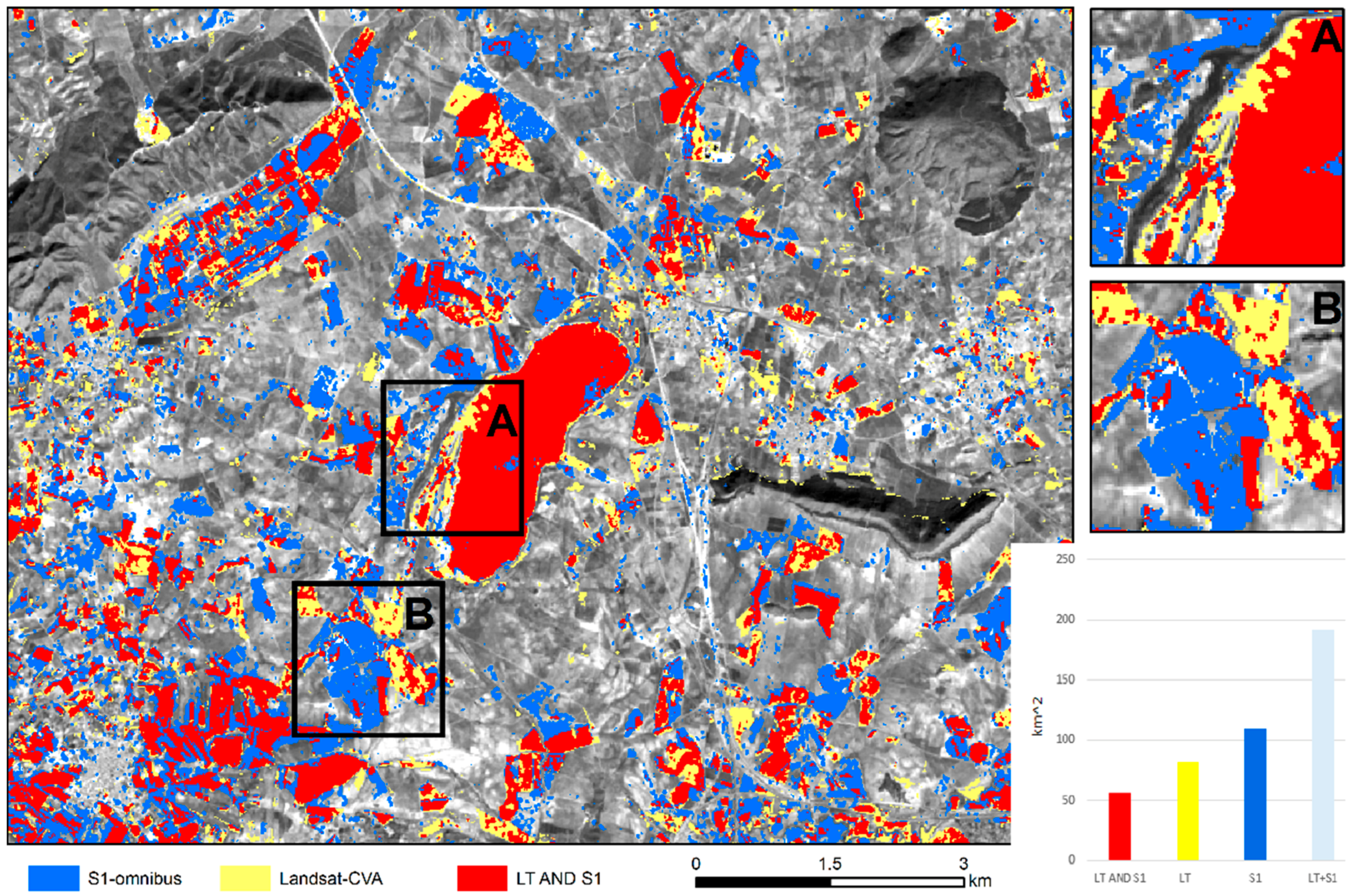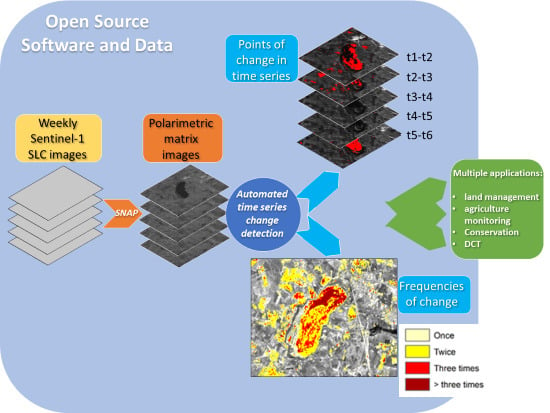1. Introduction
Wetlands are often described as ecotones, transitional habitats situated between dry land (upland) and water bodies [
1]. They are very diverse ecosystems, ranging from permanent water bodies to lands that remain completely dry over several months, or areas where water is below a dense vegetation cover, such as peat bogs or mangroves [
2]. Besides their spatial variability, some wetlands present a high temporal variability (e.g., temporal water bodies and waterways or intertidal flats). Wetlands also deliver a wide and well-recognized array of ecosystem services: flooding, drought and erosion amelioration, habitat for many keystone species, food and water supply and CO
2 sequestration, among many others [
3]. Thus, automated monitoring systems of wetlands that can capture their high temporal and spatial variability are essential for wetland management and for the quantification of the ecosystem services they provide [
4].
Landscape spatial patterns, and especially those of wetlands, are rarely static due to intra-annual changes in their ecosystem properties, whether they are caused by natural or by anthropogenic factors [
5]. Mapping of ecosystems and of long-term Land Use and Land Cover Change (LULCC) patterns may be biased by such intra-annual changes in different surface properties (e.g., phenology, hydrology, agriculture, etc.). These surface dynamics sometimes produce transitional states and fine-scale mixtures of classes that may hinder classification and long-term change detection. Some approaches have used fuzzy classifiers and multitemporal optical data to produce fractional cover maps of different wetland classes, capturing these transitional states [
6]. Additionally, [
7] proposed the term “Dynamic Cover Types” (DCT) to refer to areas of frequent periodic or seasonal change. Examples of DCT in the context of wetlands would be seasonally-inundated floodplains and inland valleys, inter-tidal flats, temporal water bodies and waterways, fields of rice and reeds when harvested or slow regrowth of some vegetation covers after flooding or harvesting events. Many of these DCT often give rise to unique species assemblages and temporal shifting of species distributions and compositions [
8,
9]. In turn, this may also affect other ecosystem functions through water and nutrient cycling.
The availability of satellite images acquired repetitively over long periods of time has allowed the proliferation of numerous change detection studies in fields, such as LULC change, forest monitoring (deforestation, regeneration, forest fires, insect defoliation), urban sprawl, landscape change and crop monitoring, among many others; [
10] provides a wide array of examples of applications in each mentioned field. Most of these techniques make use of spectral data from optical sensors to monitor long-term changes. Despite their widely-spread use and the good results obtained, optical-based change detection methods have an important disadvantage; they are hampered by illumination effects and cloud conditions, a challenge that becomes very problematic in sub-humid to humid tropics, especially during rainy seasons or when the temporal resolution is not high. SAR-based change detection methods are cloud and illumination independent, but have however been much less used because of their limited temporal and spatial availability, higher costs and more intensive processing requirements [
11]. With the recent launch of ESA’s Sentinel-1 satellite and the free access to its products, SAR-based change detection methods can now be more efficiently used to overcome some of the restrictions of optical-based methods. The high temporal resolution (six days considering Sentinel-1A and -1B at the Equator), high spatial resolution and wide swath allow for a much-needed operational change detection system, cost-free, cloud-proof and illumination independent.
SAR-based change detection methods can separate LULC classes that are especially difficult to distinguish, such as rice fields from wet grasslands. Some researchers have successfully used SAR data for rice mapping using time series [
12,
13]. Their success relies on the detection of the changes in plant morphology that take place during the three growing phases of rice per harvest, as opposed to the less frequent changes in other crops and other non-agricultural wetlands and grasslands [
12].
The operational availability of change detection approaches will be a valuable addition to currently ongoing developments of operational wetland-monitoring services, e.g., in the European “Satellite-based Wetland Observation Service” (SWOS) Horizon 2020 project [
14]. Further, it is an important contribution to the development of the Global Wetland Observation Service that is currently carried out in the framework of the Group on Earth Observations together with the Ramsar Convention on Wetlands and other global stakeholders [
15].
In this paper, we apply a polarimetric SAR-based time series change detection technique in two highly dynamic natural and semi-natural landscapes. We use a new method published in [
16] where change detection is carried out by performing a simultaneous test of the hypothesis of homogeneity for a series of SAR images. Our research was conducted with three specific objectives in mind. First, we show the potential of using the time series change detection algorithm presented in [
16] (referred to as S1-omnibus) and Sentinel-1 time series to capture short-term changes in highly dynamic areas. Second, we evaluate the performance of S1-omnibus vs. a pairwise comparison of consecutive images. According to [
16], it is expected that a larger proportion of change will be detected using the whole time series as opposed to the commonly-used pairwise approach. Third, we compare the performance of S1-omnibus with a Landsat-based change detection approach. Since optical and SAR instruments detect different properties of objects, it cannot be considered as a validation process, but it is still relevant to compare the performance of the new S1-omnibus algorithm with more extended and common approaches.
2. Study Areas
Many wetlands experience several short-term changes mostly related to water surface dynamics (seasonal water bodies and water ways, intertidal flats, temporarily inundated forests, among others) or related to human activities, such as agriculture or salt production. To test the capacities of the S1-omnibus method, we chose two highly dynamic wetlands with different characteristics.
The first one is the Lagoon of Fuente de Piedra, in southern Spain: an endorheic salty lagoon of ~13 km
2 and less than 1 m deep. Its catchment occupies around 150 km
2, but we study all of the changes within a rectangular area of 490 km
2 (
Figure 1). The lagoon is fed by two streams, although the most important supply of water is ground water inputs and rains [
17]. Landscapes in the uplands are dominated by olive groves and herbaceous crops (e.g., wheat and barley), and the lagoon was used for salt extraction during the last century. Currently, it is a Ramsar site and a nature reserve. It usually dries out at the end of spring and fills up again with the first autumn rains. Despite its small size, it is a migratory stopover for many bird species and the second largest breeding ground in Europe for the European flamingo (
Phoenicopterus roseus) [
18].
The second study area is the largest flamingo breeding ground in Europe; the French Camargue. It is coastal wetland of 130 km
2 located in the south of France, between both arms of the Rhône River Delta. It belongs to a larger and complex system of coastal wetlands and lagoons that have been flooded, dredged, canaled and cultivated during many centuries. Currently, it is a Ramsar site and a national reserve, but water is still pumped in and out for salt production and for keeping some lagoons filled during summer in certain areas. The change detection method was applied to a rectangular area of 3500 km
2 (
Figure 1). Landscapes are dominated by large permanent water bodies, rice fields and other crops, salt flats and marshes near the coast and pastures for extensive cattle. The salinity of the water bodies varies depending on the rain, but it generally increases from north to south. The deepest water body, the Vaccarés lagoon, in the center of the wetland, has a maximum depth of 2 m [
19].
Both study areas are test sites of the SWOS project, which allowed access to ground information, as well as to mapping products that were used for the interpretation of the results (e.g., LULC maps from
Figure 1). In these as in many other wetlands over the world, the presence/absence and quality of their water is influenced by land uses (mainly agricultural) in their area of hydric influence. Thus, we analyze not only the areas designated as wetland in our two study sites, but also their surroundings.
5. Discussion
For effective land management and biodiversity conservation, it is essential to understand certain landscapes as mosaics of dynamic regimes rather than simplistic static cover types [
7,
8,
9]. Temporarily-inundated wetlands belong to such category and require special approaches to assess their spatio-temporal dynamics. The statistically powerful approach we present uses free data and open source tools, which allows land planners and scientists to establish an automated and accurate monitoring service for short-term LULC change detection. We use the powerful factorization of the omnibus test statistic to perform unsupervised change analysis in two wetlands and detect areas and LULC classes of high change rates.
Locating the change patterns in space and time allows one to visualize change dynamics caused by variations in water flow or human activities. This enables us to estimate more precisely, for example, what areas dry out and when. Such estimations might be used in wetland wildlife management; breeding flamingos will abandon the single egg they lay if the wetland they are nesting in dries out too early or gets too flooded [
26].
Limnographs and gauging stations have a very good temporal resolution, but poor spatial resolution. Combining these high cadence change maps with other in situ parameters, such as the ones given by limnographs, it is possible to improve hydrological models [
27].
Maps depicting the frequency of change allow one to spot temporal and spatial patterns of short-term changes, as well as stable areas. For instance, the frequency of the change map in Fuente de Piedra shows high rates of change in the lagoon, as well as in some herbaceous crops, whereas olive groves, forest and natural shrublands remain mostly static throughout the year (
Figure 3 and
Figure 4). Most of the agricultural areas in Fuente de Piedra exhibit two changes, which suggest one harvest per year (one change from bare soil to crop and another one from crop to bare soil). Other areas of higher rates of change (three or more changes) can be spotted in agricultural areas northwest of the lagoon, suggesting several harvests per year.
In Camargue, high rates of change can be observed in the wetland south of the Vaccarés Lagoon, probably due to the influence of tides. False changes in permanent water bodies (e.g., the Mediterranean Sea) were reported when using Sentinel-1 in both approaches (i.e., S1-omnibus and the Sentinel-1 pairwise approach). Since these were not a real change and for a better visualization of the results, sea and other permanent water bodies were masked out in
Figure 3 using a permanent water mask created out of a series of Landsat images for 2015. The reasons why SAR data report changes in permanent water bodies have yet to be studied, but this might be due to variations in the water table because of the tides or due to strong winds creating waves (Bragg scattering). Such changes were not detected in the Landsat images.
Change rates were grouped into LULC classes. This revealed two groups of classes: forests, olive groves and shrublands as more “static” classes and herbaceous crops, including rice fields and wetlands, as classes prone to suffer several changes throughout a year. This allows drawing estimations of land use. For example, during the period of study (one year), no changes were reported in around 70% of the area classified as herbaceous crops of both test sites. Although a field validation would be needed, this suggests that a large portion of the area destined to grow herbaceous crops other than rice may not be actually used, but remains fallow.
The S1-omnibus method reports a larger proportion of changes in the landscape than the pairwise approach in both study areas and in both agricultural and natural landscapes. As [
16] suggested, detecting changes in consecutive pairs of images may leave undetected weak trends overtime, such as the slow growth of herbaceous vegetation after a disturbance, whether this is of anthropic origin, such as harvests, or of natural origin, like seasonal inundations. S1-omnibus seems to be able to detect these gradual changes.
The comparison of S1-omnibus and Landsat-CVA showed generally good agreement in Fuente de Piedra, with changes in some patches of herbaceous crops missed by either of the methods (
Figure 6). In Camargue, optical and SAR methods performed more differently. Landsat-CVA flagged as change a larger extent, mainly of herbaceous crops other than rice. This might be due to phenological changes in blooming vegetation that are difficult to detect with SAR imagery.
The comparison between the water table and precipitation data and the sequence of changes detected by S1-omnibus (
Figure 2) reveal how important it is to have a high cadence of imagery to capture all of the changes produced in such dynamic ecosystems. We limited our research to one Sentinel-1 image per month (every 24 or 36 days) for simplification purposes, but with the recent launch of Sentinel-1B, it is now possible to map these dynamics every six days. It would not be possible to reach even a similar cadence using optical data. Although both study areas are relatively cloud-free throughout the year, we could only find 6–8 cloud-free Landsat scenes for our test sites, all restricted to the dry period. The lack of suitable optical images is greater for larger areas (the larger the area is, the more probable it is to find clouds in it), during rainy seasons and especially in the sub-humid and humid tropics. Some events, like fast floods or flooding of certain creeks or ponds, may take place only during the rainy season.
Potentials and Limitations of the Application
Although S1-omnibus cannot directly provide information on the type of change, this approach can still be useful for land managers with local knowledge or in situ data that allow them to interpret the changes and change rates. Knowing the short-term change patterns of certain land covers may aid in their classification, especially when classifying different types of wetlands, since some of them are defined by their dynamics. For instance, wet meadows are defined by seasonally- or temporally-saturated soils and brief periods of inundation [
7]. Such periods of inundation can be accurately mapped using Sentinel-1 time series in order to define subclasses of wetlands and further describe the ecological status and condition of DCT. The increased temporal resolution of Sentinel-1 time series provides an information source for a better physically-based characterization of wetland types following a standardized nomenclature, e.g., Ramsar, or the Mapping and Assessment of Ecosystems and their Services (MAES). Integrating the S1-omnibus approach in operational wetland mapping activities fosters a more systematic monitoring of wetland dynamics. The broad change results thus provide a very flexible application for analyzing specific hydrological or plant phenology-driven analyses at very local scales.
Dual pol SAR data have been used before to monitor grass cutting practices for biodiversity management and subsidy control purposes, but the number of studies available is limited [
28]. In fields of tall grass, meteorological conditions such as wind can influence the backscatter signal, reporting a change when there was actually none [
28]. In a pairwise comparison of consecutive images, it is difficult to remove such influence, but it may be possible to filter that noise out by applying S1-omnibus; if using time series with a high temporal resolution, (e.g., weekly), the algorithm could be modified so that if
, but
, the change reported between
and
could be flagged as a false positive.
The different changes recorded by Landsat-CVA and S1-omnibus show the potential of combining optical and SAR sensors for change detection. Sentinel-1-based change detection can also be combined with other sensors to determine the direction of change and to create a change mask to reduce error propagation in the labeling phase of the production of long-term LULCC maps [
11].
Sentinel-1 does not always acquire dual-pol images, and for certain parts of the globe during certain periods, only single polarization (VV) images are available. Information on the schedule of different acquisition modes can be found at
https://sentinel.esa.int/web/sentinel/missions/sentinel-1/observation-scenario. We also tested the S1-omnibus approach with single-pol VV Sentinel-1 images, and the results looked promising, but the accuracy has yet to be evaluated. An important limitation is the inherent low vegetation canopy penetration of C-band. This hinders its application for wet forests and mangroves, for which an L-band sensor would be more suitable.
It is still necessary to determine with more exactitude the change detection capabilities of S1-omnibus; e.g., how tall/thick the vegetation must be for it to be detected when it is removed or grows. Additional work to validate this change detection methodology with time series is underway using a variety of test sites where we have a higher level of control.
The open source character of our approach allows its incorporation with other tools where dense time series may be used, such as Google Earth Engine or the future SWOS portal and toolbox, which in turn may increase the number of applications of the S1-omnibus.

